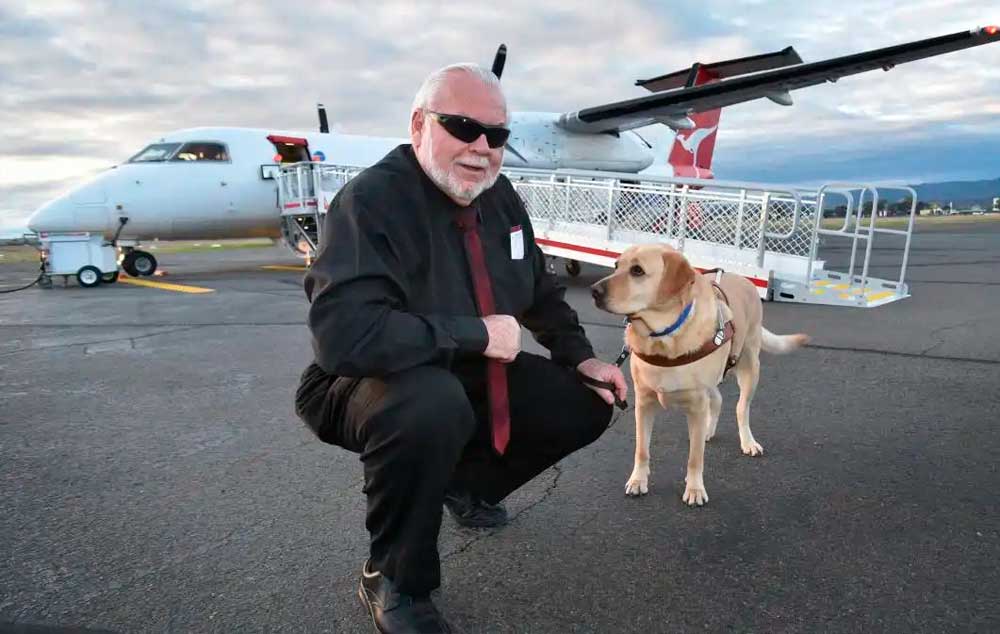
Tips and Tricks from a Blind Business Traveler: How to Manage the Airport More Effectively
J.J. Meddaugh
My career as an accessibility specialist affords me the opportunity to travel around the country for conferences, exhibits, and other events. Travel is one of the most fun and rewarding parts of my job, and it allows me to experience cities and local culture that I may not have been able to otherwise. Through all of this, I have become a rather seasoned traveler by necessity, developing many skills and tricks for navigating through airports and other unfamiliar areas. Janet Ingber discusses what to expect when going through airport security in the September 2012 issue of AccessWorld, but this is only one part of the travel experience. Below, I offer some antidotes and ideas for airport travel based on what I’ve learned over the past several years of my business and personal travel.
Before I continue, it’s worth reminding you that these tips and ideas are merely my personal method for traveling independently. Your comfort level, mobility experience, and common sense may all dictate whether or not these tips are also suitable for your situation. Also, travel is not always an exact science. Many situations can occur on the day of a flight, such as gate changes, cancelations, and unforeseen delays. Remember that these are events that affect everyone who is traveling, not just you.
To Ask or Not to Ask for Assistance
Much of the discussion surrounding independent, efficient travel is about whether or not to request assistance when traveling. By assistance, I’m referring to an escort, motorized cart, or other means to transport you from one gate to another. When I first traveled, I often accepted whatever the airline offered me in the interest of time, laziness, or other factors. However, as time went by, I came to the conclusion that this so-called assistance was causing me more harm than good.
Let’s put aside any philosophical arguments about blindness and focus on the actual travel experience for a moment. When I was offered assistance by an airport or airline representative, it was often less than I bargained for. Sometimes, I would wait at the gate for 10 to 15 minutes for someone to show up. If this person did finally arrive, they often were hard to understand, adding uncertainty to my journey. If they offered a sighted guide, it was often difficult to explain to them proper techniques, or the guide walked at such a painfully slow pace that I felt like I could read an entire novel before I arrived at my gate. Were there some good assistants? Absolutely, but more often than not, I felt like my time was being wasted.
Self-Sufficient Travel
The alternative to not asking for assistance, going it alone, can seem quite daunting, especially if you’ve never done it before. I’ve experienced that uncertainty as well, but I started to realize the numerous advantages this method offers. Here are some tips that I’ve used to help make the airport experience manageable.
Before you Go
Much of my independence in traveling is gained before I even step foot in the airport. If I am planning to travel to an unfamiliar airport, I will attempt to learn a bit about its layout before I get there. Wikipedia is a good source for this information and can provide such tidbits as how many gates are in each concourse, if there is a tram or other transportation that goes between concourses, and where the gates for a particular airline are located.
If I will be going through a connecting airport or plan on having some additional time, I will scope out the airport’s website for a restaurant guide. Many airport sites now include specific information on each available eatery, including the nearest gate to the restaurant. A review site like Yelp can offer additional clues as to the most popular or best restaurants at a particular airport.
I also maintain easy access to my flight numbers and gate information, so I know where I should be headed after passing through security and at the connecting airport. A great service for managing travel information is TripIt, which allows you to see all of your flight, hotel, and other itinerary info in one place. This can be viewed on the TripIt website or with its free iOS or Android apps.
Checking In
If you can, obtain your boarding pass before arriving at the airport. This will allow you to jump straight to security if you have no bags to check and avoid any customer service agents who may be overly persistent about offering help. Many airlines now offer mobile apps for checking in and obtaining boarding passes, negating the need for a printer. In our tests, these apps are generally accessible for retrieving boarding information. If I do need to speak to someone to check in for a flight or check a bag, I have recently started to specifically ask the agent to not add any special assistance requests on my reservation. Sometimes, they will add such requests without asking you, leading to an awkward situation later in your travel.
Getting Around the Airport
In many airports, gates are arranged in numerical order in long hallways. Some airports have all of the gates on your left or right side while others will have odd numbered gates on one side and evens on the other side. Food courts, gift shops, kiosks, bathrooms, and other services will also often be present along these concourses. There are usually steady streams of people walking in either direction down the concourse, making it easy to stay on track. Sometimes, I will ask passersby what the nearest gate is to me and attempt to determine if the numbers go up or down in the direction I am facing. This is also where that all-important food information comes into play. If I know my favorite restaurant is near gate B-7, I can seek it out on my way through the concourse.
If I’m going to be connecting to another flight, I will verify the gate information as soon as the first flight has landed. You are free to use your cell phone as soon as the airplane touches down on the runway. This usually allows for ample time to check your connecting flight information, so you know your next gate before you get off of the plane. This double check method has saved me on several occasions as gates often change before takeoff.
Who knows, you may get lucky and have your connecting flight at the gate right next door.
Handling Delays
Let’s face it. Flights are not always on time, and while your initial reaction may be to get frustrated, this doesn’t help the situation. Before I go to the airport, I attempt to look up the available flights for that day from my airline. This step may seem a bit tedious, but you will thank yourself if your flight is delayed because you will already have an idea of other flight options to get you to your destination. If your flight arrives late and you are going to miss your connecting flight, avoid the long customer line that is likely to form and call the airline’s toll-free number. I can remember one instance where my first flight was stuck on the runway for over an hour and it was clear I was going to miss my connecting flight. I called the airline during this downtime and explained the situation and had my new flight booked before I even left. Also, if your flight is delayed and you have not boarded the plane, do not go far from your gate. A common misconception is that a delayed flight will not become less delayed. If your flight is delayed for two hours but the airline finds another plane in the meantime, they can and often will reschedule the flight to leave earlier. I have seen many novice travelers stranded because they left to get food or explore the airport and missed their new boarding time.
Retrieving Baggage
If you must check baggage, there are a couple of things you can do to make the retrieval of your luggage a simple process. First, an audible luggage locator can help you to quickly find your bag as it travels around the carousel. This allows you to press a button, which will activate a beeping locator in your bag. Also, consider marking your bag with brightly-colored tape or another distinctive element. Asking someone to locate a black suitcase will likely result in frustration as there may be 20 other black suitcases on the same carousel.
A Further Word about Assistance
I want to clarify an important distinction between getting airport assistance and asking for help. I have no shame in asking for help when I need it. I don’t have a photographic memory or an on-call mental map of every airport, and sometimes time is of the essence. However, I prefer to do this on my own time and intuition. Sometimes, I will strike up a conversation with my seat mate and learn they are traveling to the same city I am, or I will find someone who is also headed toward baggage claim or ground transportation. I have no shame in following someone, and it’s always interesting to meet new people and hear about their lives. I just don’t want an airport or airline to dictate when I need help and control my life.
Independence is your Right
Despite what any airport employee may try to tell you, you cannot be forced into accepting any assistance that is offered to you. You have the right to choose the accommodations or lack thereof that is best for your situation. Just because a security guard may say it’s easier to push you around in a wheelchair doesn’t mean you are obligated to take their help. You can always say, “No thanks.”
Conclusion
Traveling through unfamiliar spaces can seem like a daunting experience. Remember that many people, blind or sighted, share the same challenges that you do and are also moving through an unknown space. If you are scared of missing your flight, try arriving at the airport a bit earlier than normal until you get used to traveling by yourself. I hope some of these tips and ideas will help you to become a more ambitious and independent traveler. There’s an entire world out there just waiting for you to visit.
Source: Access World
Compartilhe
Use os ícones flutuantes na borda lateral esquerda desta página
Siga-nos!
Envolva-se em nosso conteúdo, seus comentários são bem-vindos!
Artigos relacionados
Acessibilidade no ESG. Equipotel aborda o tema para o turismo.
Acessibilidade no ESG, para o mercado do turismo. Equipotel aborda a importância da inclusão da pessoa com deficiência.
Morte Sobre Rodas. Filme inclusivo foi candidato ao Oscar.
Morte Sobre Rodas. Dois protagonistas do filme, são pessoas com deficiência, um usuário de cadeira de rodas e outro com paralisia cerebral.
Paralimpíada de Paris 2024. A deficiência não é um limite.
Paralimpíada de Paris 2024. A cidade luz sedia o maior evento esportivo do mundo para as pessoas com deficiência.






0 comentários